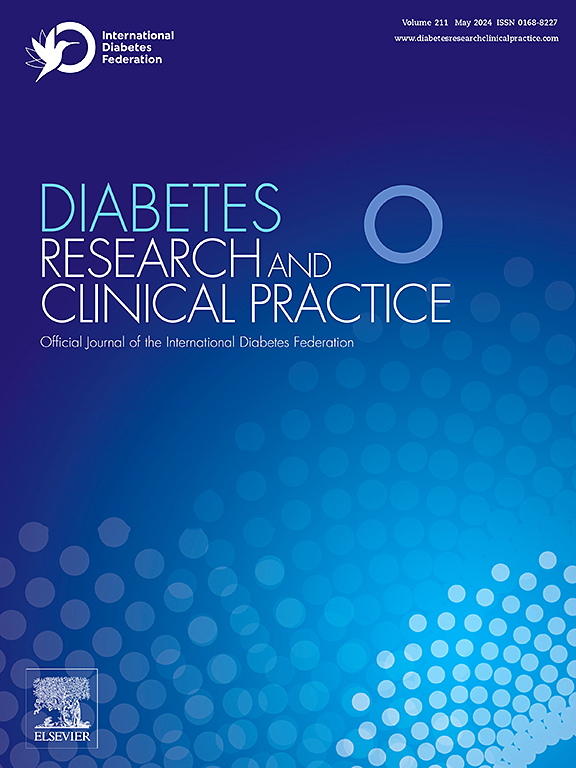The automated correction index (ACI), a novel report-derived metric correlated to glucose control and variability in patients with type 1 diabetes on advanced hybrid closed loop therapy
IF 6.1
3区 医学
Q1 ENDOCRINOLOGY & METABOLISM
引用次数: 0
Abstract
Objective
This study aimed to correlate the parameters of advanced hybrid closed loop (AHCL) function to the glycometabolic outcomes in a cohort of patients with type 1 diabetes (T1D) using different AHCL systems.
Research design and methods: This was a retrospective cross-sectional study on 124 adult (n = 87) and pediatric (n = 37) patients correlating the total daily insulin dose (TDD), the total daily basal (TDBa) and bolus (TDBo) insulin doses, the percentage of auto-bolus out of total daily bolus (Automated Correction Index − ACI) to the glycated hemoglobin (HbA1c) and the sensor-derived metrics.
Results
The ACI was the only AHCL-derived parameter directly associated to HbA1c (p = 0.03) and time above range (TAR180-250 mg/dL, 10-13.9 mmol/L, p < 0.01), and inversely correlated to time in range (TIR70-180 mg/dL, 3.9-10 mmol/L, p < 0.01). Patients with ACI < 30 % showed reduced HbA1c levels (6.21 % ± 0.5 vs. 6.95 % ± 0.8, p = 0.02) and a higher probability of having TIR > 70 % (OR 3.18, CI 1.19–8.46, p = 0.02) and coefficient of variation (CV) < 36 % (OR 2.86, CI 1.07–8.27, p = 0.03) compared to those with ACI ≥ 30 %.
Conclusion
The ACI could represent a useful and easy-to-assess metric for AHCL-treated individuals with T1D. In our cohort an ACI < 30 % was associated to better glucose control and variability.
自动校正指数(ACI)是一种新的报告衍生指标,与1型糖尿病患者接受晚期混合闭环治疗的血糖控制和变异性相关
目的本研究旨在探讨使用不同AHCL系统的1型糖尿病(T1D)患者晚期混合闭环(AHCL)功能参数与糖代谢结局的相关性。研究设计和方法:这是一项针对124名成人(n = 87)和儿科(n = 37)患者的回顾性横断面研究,将每日总胰岛素剂量(TDD)、每日总基础(TDBa)和大剂量(TDBo)胰岛素剂量、自动大剂量占每日总大剂量的百分比(自动校正指数- ACI)与糖化血红蛋白(HbA1c)和传感器衍生指标相关联。结果ACI是唯一与HbA1c直接相关的ahcl衍生参数(p = 0.03),且时间高于(tar180 ~ 250 mg/dL, 10 ~ 13.9 mmol/L, p <;0.01),且与时间呈负相关(TIR70-180 mg/dL, 3.9-10 mmol/L, p <;0.01)。ACI <患者;30%的患者HbA1c水平降低(6.21%±0.5 vs. 6.95%±0.8,p = 0.02),发生TIR和gt的可能性更高;70% (OR 3.18, CI 1.19-8.46, p = 0.02),变异系数(CV) <;36% (OR 2.86, CI 1.07-8.27, p = 0.03)与ACI≥30%的患者相比。结论ACI对ahcl治疗的T1D患者是一个有用且易于评估的指标。在我们的队列中,一个ACI <;30%与更好的血糖控制和可变性有关。
本文章由计算机程序翻译,如有差异,请以英文原文为准。
求助全文
约1分钟内获得全文
求助全文
来源期刊

Diabetes research and clinical practice
医学-内分泌学与代谢
CiteScore
10.30
自引率
3.90%
发文量
862
审稿时长
32 days
期刊介绍:
Diabetes Research and Clinical Practice is an international journal for health-care providers and clinically oriented researchers that publishes high-quality original research articles and expert reviews in diabetes and related areas. The role of the journal is to provide a venue for dissemination of knowledge and discussion of topics related to diabetes clinical research and patient care. Topics of focus include translational science, genetics, immunology, nutrition, psychosocial research, epidemiology, prevention, socio-economic research, complications, new treatments, technologies and therapy.
 求助内容:
求助内容: 应助结果提醒方式:
应助结果提醒方式:


